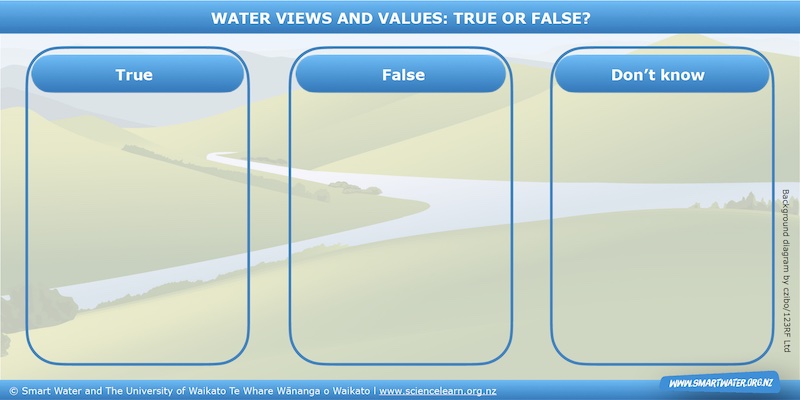Te mana o te wai describes the first right for water being with the water – rivers, lakes and streams as well as the ocean. After human water uses, there must be enough natural flow remaining to keep the rivers functioning as they should for our endemic animals and to enable essential natural processes to occur. The health and wellbeing of water is of vital importance for all living things and must come before other concerns.
This activity is part of a suite of resources that support Smart Water – a context for learning, which provides students and teachers with opportunities to connect with water and learn more about drinking water in the Waikato region. The science and mātauranga concepts that underpin Smart Water are transferable to other locations in Aotearoa New Zealand.
Prior to conducting this activity, teachers may find it useful to read the article Managing classroom discussions. It provides helpful tips for creating a positive climate for discussion.
In this activity, students explore the concept of te mana o te wai and mauri (the dynamic life force energy).
By the end of this activity, students should be able to:
- use an interactive organiser to sort statements according to personal values and views
- explain what is meant by te mana o te wai
- describe the concept of mauri
- reflect on their personal values around water and te mana o te wai.
Download the Word file (see link below).
Nature of science
Social and cultural elements affect how science knowledge is produced and how it is accepted. Science changes to reflect shifts in society and its priorities. Water was once viewed by parts of society as a commodity whereas many now recognise that the health and wellbeing of water must come before other concerns.
Related content
Smart Water – a context for learning groups Smart Water resources into key science and teaching concepts that underpin water conservation.
Wai Māori curates resources that explore some of the values and connections between iwi, wai and awa and the work of Waikato Māori to look after their taonga.
Rivers and Us – a context for learning has pedagogical information and links to numerous resources that explore water use and water quality.
Activity ideas
Other activities in Smart Water:
- Getting to know water collects students’ prior knowledge and experiences of freshwater as the starting point to form an inquiry plan.
- Water in nature explores states of matter in the water cycle.
- Water in the Waikato explores the major freshwater features and sources of water for the Waikato region.
- Global water perspectives explores water availability and water stress around the world, with comparison and reflection on Aotearoa New Zealand’s situation.
- Getting water ready to drink explores the drinking water treatment process.
- Water use challenge investigates how much water we need for our daily tasks.
- Water issues and effects explores water issues in the Waikato region, their effects and alternative possibilities.
- Being smart with water uses the knowledge gained from the ongoing inquiry to make a difference in how we use water.
Useful links
Visit Smart Water for water level alerts, water saving tips and more.
Watch the Ministry for the Environment video Te mana o te wai: Introduction and overview.
See the articles in the New Zealand Journal of Marine and Freshwater Research 2018 Special Issue: Mātauranga Māori shaping marine and freshwater futures.
River Swimming is a poem by Lynley Edmeades and published in School Journal level 3 2018. The text is available in TKI Literacy online.
Water New Zealand has Māori Language Week 2020 te mana o te wai posters available as A4 and A3 PDF downloads.
New Zealand Parliament made the Whanganui River a person in the eyes of the law in 2017. In 2014, Te Urewera was granted legal personhood.
Acknowledgement
This resource has been produced with the support of Smart Water.


